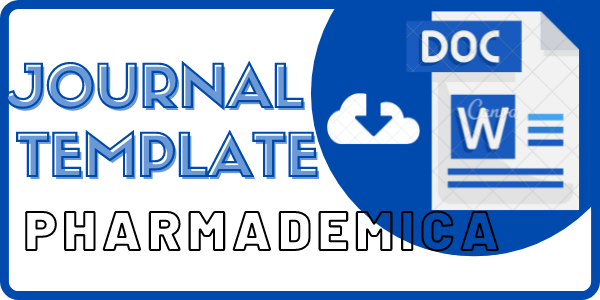Physical Quality and Chemical Quality of Solid Soap with Various Concentrations of Turmeric Extract (Curcuma domestica)
DOI:
https://doi.org/10.54445/pharmademica.v3i2.44
 Abstract View:
Abstract View:
732
 PDF downloads:
PDF downloads:
1384
Keywords:
Turmeric extract, Physical quality, Chemical quality, Solid SoapAbstract
Turmeric (Curcuma domestica) contains curcumin which can provide antioxidant and antibacterial activity. Curcumin can also be used as a natural brownish yellow dye at alkaline pH, so it can be used as an additional ingredient in making solid soap. This research aims to determine the physical quality a chemical quality of solid soap preparations with varying concentrations of turmeric extract. This research includes descriptive research which includes making turmeric extract, making solid soap with varying concentrations of turmeric extract concentration of 2 gram (F1), 3 gram (F2) and 4 grams (F3) as well as physical quality testing which includes organoleptic, water content, foam stability and chemical quality testing include pH, fee alkali and free fatty acids. The results of the physical quality test of the 3 soaps formulation were brown soap, solid and odourless. Water content for F1: 0,6486%, F2: 0,4897%, F3: 0,5228%. Foam stability for F1: 5,5 cm, F2: 5,3 cm, F3: 5,3 cm. The chemical quality test result for pH are F1: 8,54, F2: 8,81, F3: 8,94 while free alkali for F1: 0,0428%, F2: 0,0429% dan F3: 0,0461%. Based on the research that has been carried out, it can be conclude that the three solid soap formulas with varying concentrations of turmeric extract have content, foam stability, pH and free alkali in accordance with SNI-3532-2016.
Downloads
References
Andi Nurpati Panaungi. (2022). Pembuatan Sabun Padat Dari Minyak Kelapa Dengan Penambahan Ekstrak Buah Pare (Momordica Charantia L) Sebagai Antioksidan Menggunakan Metode Cold Process. Borneo Journal of Pharmascientech, 6(1), 38–48. https://doi.org/10.51817/bjp.v6i1.443
Asnani, A., Delsy, E. V. Y., & Diastuti, H. (2019). Transfer Teknologi Produksi Natural Soap-Base untuk Kreasi Sabun Suvenir. Jurnal Pengabdian Kepada Masyarakat (Indonesian Journal of Community Engagement), 4(2), 129. https://doi.org/10.22146/jpkm.33581
Auliyah, S. I. ; ariani. (2019). Kajian pH dan Kadar Air Dalam SNI Sabun Mandi Padat Di JABEDEBOG Study of pH and Moisture Content in SNI of Bar Bath Soap in Jabedebog.
Jalaluddin, J., Aji, A., & Nuriani, S. (2019). Pemanfaatan Minyak Sereh (Cymbopogon nardus L) sebagai Antioksidan pada Sabun Mandi Padat. Jurnal Teknologi Kimia Unimal, 7(1), 52. https://doi.org/10.29103/jtku.v7i1.1170
Maulidha, F., & Dewajani, H. (2023). Pemilihan Jenis Minyak Dalam Pembuatan Sabun Mandi Cair Dengan Metode Hot Process. DISTILAT: Jurnal Teknologi Separasi, 8(4), 876–882. https://doi.org/10.33795/distilat.v8i4.490
Ngete, A. F., & Mutiara, R. I. F. (2020). Penggunaan Pewarna Alami Sebagai Upaya Meningatkan Kualitas Kesehatan. Jurnal Kesehatan Tujuh Belas (Jurkes TB), 1(2), 130–135.
Rizky, A. O. O., Purwati, E., & Safitri, C. I. N. H. (2021). Formulasi dan Uji Mutu Fisik Sediaan Sabun Padat Ekstrak Daun Kelor (Moringa oleifera L.). Journal Proceeding of Mulawarman Pharmaceuticals Conferences, 5(April 2021), 2614–4778.
Savitri, I., Suhendra, L., & Wartini, N. M. (2017). Pengaruh Jenis Pelarut Pada Metode Maserasi Terhadap Karakteristik Ekstrak Sargassum polycystum. 5(3), 93–101.
Sukawaty, Y., Warnida, H., & Artha, A. V. (1994). Formulasi Ssediaan Sabun Mandi Padat Ekstrak Etanol Umbi Bawang TiwaiI ( Eleutherine bulbosa ( Mill .) Urb .)
Suryani,N.C., Purwana,D.G., Jambe,A (2016). Pengaruh Jenis Pelarut Terhadap Kandungan Total Flavonoid dan Aktifitas Antioksidan Ekstrak Daun Matoa (Pometia pinnata) Jurnal Ilmu dan Teknologi Pangan Universitas Udayana, Vol 5 No.1 ( 2016)
SNI-3532-2016
Widyasanti, A., Winaya, A. T., & Rosalinda, S. (2019). Pembuatan Sabun Cair Berbahan Baku Minyak Kelapa Putih 13(2), 132–142.
Yong-Bing, X., Gui-Lin, C., & Ming-Quan, G. (2019). Antioxidant and anti-inflammatory activities of the crude extracts of moringa oleifera from kenya and their correlations with flavonoids. Antioxidants, 8(8), 1–12. https://doi.org/10.3390/antiox8080296
Downloads
Published
How to Cite
Issue
Section
License
Copyright (c) 2024 wahyu wuryandari, Andreas Candra Firnanda

This work is licensed under a Creative Commons Attribution-ShareAlike 4.0 International License.









.png)








